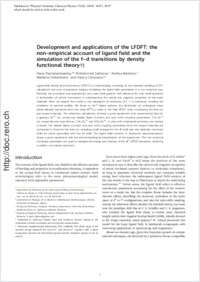Development and applications of the LFDFT: the non-empirical account of ligand field and the simulation of the f–d transitions by density functional theory
- Ramanantoanina, Harry Department of Chemistry of the University of Fribourg, Switzerland
- Sahnoun, Mohammed Laboratoire de Physique de la Matière et Modélisation Mathématique, LPQ3M, Université de Mascara, Algeria
- Barbiero, Andrea Department of Chemistry of the University of Fribourg, Switzerland
- Ferbinteanu, Marilena Faculty of Chemistry, Inorganic Chemistry Department, University of Bucharest, Romania
- Cimpoesu, Fanica Institute of Physical Chemistry, Bucharest, Romania
-
08.07.2015
Published in:
- Physical Chemistry Chemical Physics. - 2015, vol. 17, no. 28, p. 18547–18557
English
Ligand field density functional theory (LFDFT) is a methodology consisting of non-standard handling of DFT calculations and post-computation analysis, emulating the ligand field parameters in a non-empirical way. Recently, the procedure was extended for two-open-shell systems, with relevance for inter-shell transitions in lanthanides, of utmost importance in understanding the optical and magnetic properties of rare-earth materials. Here, we expand the model to the calculation of intensities of f → d transitions, enabling the simulation of spectral profiles. We focus on Eu²⁺-based systems: this lanthanide ion undergoes many dipole-allowed transitions from the initial 4f⁷(⁸S7/2) state to the final 4f⁶5d¹ ones, considering the free ion and doped materials. The relativistic calculations showed a good agreement with experimental data for a gaseous Eu²⁺ ion, producing reliable Slater–Condon and spin–orbit coupling parameters. The Eu²⁺ ion-doped fluorite-type lattices, CaF₂:Eu²⁺ and SrCl₂:Eu²⁺, in sites with octahedral symmetry, are studied in detail. The related Slater–Condon and spin–orbit coupling parameters from the doped materials are compared to those for the free ion, revealing small changes for the 4f shell side and relatively important shifts for those associated with the 5d shell. The ligand field scheme, in Wybourne parameterization, shows a good agreement with the phenomenological interpretation of the experiment. The non-empirical computed parameters are used to calculate the energy and intensity of the 4f⁷–4f⁶5d¹ transitions, rendering a realistic convoluted spectrum.
- Faculty
- Faculté des sciences et de médecine
- Department
- Département de Chimie
- Language
-
- English
- Classification
- Chemistry
- License
-
License undefined
- Identifiers
-
- RERO DOC 257158
- DOI 10.1039/C5CP02349A
- Persistent URL
- https://folia.unifr.ch/unifr/documents/304396
Other files
Statistics
Document views: 119
File downloads:
- pdf: 138
- Supplementary material: 124

